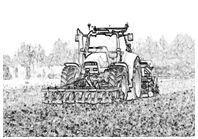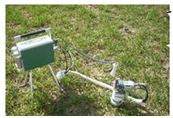In addition to its, evident, food supply function, agriculture is subjected to various pressures and has to respond to many challenges like reducing its CO2 emissions, maintaining or improving the soil quality, maintaining productivity, sequestrating carbon in the soil…
Cultivation practices are known to induce a modification of soil organic matter quantity, quality and spatial distribution, which may impact dry matter decomposition kinetics.
Project
 “SOLRESIDUS” is a multidisciplinary project. Our objective is to investigate the impact of cultivation practices (tillage and residue restitution) on crop growth, yield and environment, as well as on soil properties and on soil biodiversity. This project gathers 8 Research Units of GxABT (ULg) and one Department of Walloon Agricultural Research Centre (CRA-W) since October 2009. Some measurements had started with experimental site setup, in September 2008.
“SOLRESIDUS” is a multidisciplinary project. Our objective is to investigate the impact of cultivation practices (tillage and residue restitution) on crop growth, yield and environment, as well as on soil properties and on soil biodiversity. This project gathers 8 Research Units of GxABT (ULg) and one Department of Walloon Agricultural Research Centre (CRA-W) since October 2009. Some measurements had started with experimental site setup, in September 2008.
Site description
The experimental site is located in Gembloux, about 45 km at the south-east of Brussels in Belgium. The experimental design is a 4 latin squares. It is composed by 16 plots of 15*40m where we study the crossed impacts of tillage (traditional tillage vs reduced tillage) and crop residue management (restitution vs exportation).
The Unit of Biosystem Physics in SOLRESIDUS : Analysis of Soil respiration
Soil respiration was measured for 3 years with automatic and manual dynamic soil chambers. Moreover, soil respiration was measured as well in cropping zone (total respiration) as in root exclusion zones created with root exclusion cylinders (heterotrophic respiration). At the same time, soil humidity and temperature measurements were made in the first 5cm near to the collars.
We used sixteen homemade chambers which are automatic closed dynamic chambers (Norman et al., 1992; Longdoz et al., 2000; Davidson et al., 2002, Suleau et al., 2009). These soil chambers are set-up on 2 ploughed plots to compare residues impacts.
The device we use is a Li-Cor 6400 equipped with LiCor 6400-09 soil chamber which is put on a fixed collar. We measure CO2 fluxes one time per week for the two types of respiration. We have four collars by plot (16 repetitions by modality).
As first results, we observed:
- significantly higher fluxes in plots with residue restitution, which is clearly explained by the larger amount of organic carbon prone to decomposition (Livre blanc, Février, 2011)
- a decrease of standardized heterotrophic respiration (linked with residue decomposition) during growing seasons
- no significant differences in soil respiration between tillage modalities after 3 growing seasons (Livre blanc, Février, 2011).
The experiment is still in progress, more years being necessary in order to evaluate the long-term impacts of cultivation practices on soil respiration.
Delphine Dufranne et Rémy Locquet



